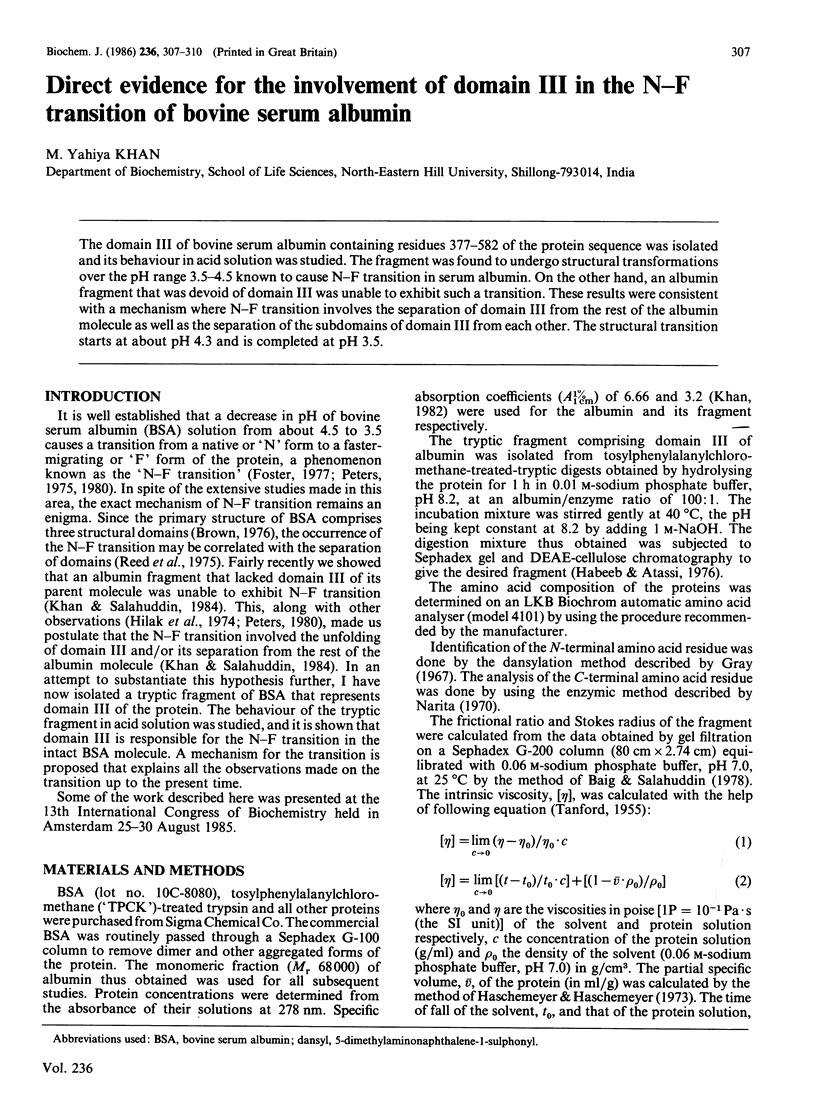Abstract
The domain III of bovine serum albumin containing residues 377-582 of the protein sequence was isolated and its behaviour in acid solution was studied. The fragment was found to undergo structural transformations over the pH range 3.5-4.5 known to cause N-F transition in serum albumin. On the other hand, an albumin fragment that was devoid of domain III was unable to exhibit such a transition. These results were consistent with a mechanism where N-F transition involves the separation of domain III from the rest of the albumin starts at about pH 4.3 and is completed at pH 3.5.
Full text
PDF



Selected References
These references are in PubMed. This may not be the complete list of references from this article.
- Ahmad F., Salahuddin A. Influence of temperature on the intrinsic viscosities of proteins in random coil conformation. Biochemistry. 1974 Jan 15;13(2):245–249. doi: 10.1021/bi00699a003. [DOI] [PubMed] [Google Scholar]
- Baig M. A., Salahuddin A. Occurrence and characterization of stable intermediate state(s) in the unfolding of ovomucoid by guanidine hydrochloride. Biochem J. 1978 Apr 1;171(1):89–97. doi: 10.1042/bj1710089. [DOI] [PMC free article] [PubMed] [Google Scholar]
- Brown J. R. Structural origins of mammalian albumin. Fed Proc. 1976 Aug;35(10):2141–2144. [PubMed] [Google Scholar]
- Feldhoff R. C., Peters T., Jr Fragments of bovine serum albumin produced by limited proteolysis. Isolation and characterization of peptic fragments. Biochemistry. 1975 Oct 7;14(20):4508–4514. doi: 10.1021/bi00691a027. [DOI] [PubMed] [Google Scholar]
- Geisow M. J., Beaven G. H. Physical and binding properties of large fragments of human serum albumin. Biochem J. 1977 Jun 1;163(3):477–484. doi: 10.1042/bj1630477. [DOI] [PMC free article] [PubMed] [Google Scholar]
- Habeeb A. F., Atassi M. Z. A fragment comprising the last third of bovine serum albumin which accounts for almost all the antigenic reactivity of the native protein. J Biol Chem. 1976 Aug 10;251(15):4616–4621. [PubMed] [Google Scholar]
- Hilak M. C., Harmsen B. J., Braam W. G., Joordens J. J., Van Os G. A. Conformational studies on large fragments of bovine serum albumin in relation to the structure of the molecule. Int J Pept Protein Res. 1974;6(2):95–101. doi: 10.1111/j.1399-3011.1974.tb02366.x. [DOI] [PubMed] [Google Scholar]
- Khan M. Y., Salahuddin A. Lack of N--F transition in the N-terminal fragment (domain I + II) of bovine serum albumin. Eur J Biochem. 1984 Jun 15;141(3):473–475. doi: 10.1111/j.1432-1033.1984.tb08216.x. [DOI] [PubMed] [Google Scholar]
- King T. P. Limited pepsin digestion of bovine plasma albumin. Arch Biochem Biophys. 1973 Jun;156(2):509–520. doi: 10.1016/0003-9861(73)90300-7. [DOI] [PubMed] [Google Scholar]
- LUZZATI V., WITZ J., NICOLAIEFF A. [The structure of bovine serum albumin in solution at pH 5,3 and 3,6: study by the absolute central diffusion of x-rays]. J Mol Biol. 1961 Aug;3:379–392. doi: 10.1016/s0022-2836(61)80051-x. [DOI] [PubMed] [Google Scholar]
- Narita K. End group determination. Mol Biol Biochem Biophys. 1970;8:25–90. doi: 10.1007/978-3-662-12834-3_3. [DOI] [PubMed] [Google Scholar]
- Peters T., Jr, Feldhoff R. C. Fragments of bovine serum albumin produced by limited proteolysis. Isolation and characterization of tryptic fragments. Biochemistry. 1975 Jul 29;14(15):3384–3391. doi: 10.1021/bi00686a015. [DOI] [PubMed] [Google Scholar]
- Reed R. G., Feldhoff R. C., Clute O. L., Peters T., Jr Fragments of bovine serum albumin produced by limited proteolysis. Conformation and ligand binding. Biochemistry. 1975 Oct 21;14(21):4578–4583. doi: 10.1021/bi00692a004. [DOI] [PubMed] [Google Scholar]
- Reed R. G., Putnam F. W., Peters T., Jr Sequence of residues 400--403 of bovine serum albumin. Biochem J. 1980 Dec 1;191(3):867–868. doi: 10.1042/bj1910867. [DOI] [PMC free article] [PubMed] [Google Scholar]
- Tanford C. Protein denaturation. Adv Protein Chem. 1968;23:121–282. doi: 10.1016/s0065-3233(08)60401-5. [DOI] [PubMed] [Google Scholar]


